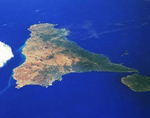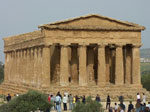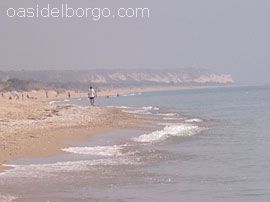|
What in Sicily
Sicily,
the largest and most important of the Mediterranean islands (25,708km2),
owed its ancient name Trinacria to its
 triangular
shape. The modern name Sicilia is derived from that of its ancient
inhabitants, the Sicels or Siculi. Physically it is a continuation of the
chain of the Apennines on the one hand, and of the Atlas mountains on the
other. But it appears that far from Sicily being joined at a comparatively
recent epoch to Calabria, the Strait of Messina is actually narrower now than
in former ages. The island is mountainous across the north
and easth, with plateaux in the centre, lowering
towards the south, and fertile coastal plains. Etna,
the largest volcano in Europe, triangular
shape. The modern name Sicilia is derived from that of its ancient
inhabitants, the Sicels or Siculi. Physically it is a continuation of the
chain of the Apennines on the one hand, and of the Atlas mountains on the
other. But it appears that far from Sicily being joined at a comparatively
recent epoch to Calabria, the Strait of Messina is actually narrower now than
in former ages. The island is mountainous across the north
and easth, with plateaux in the centre, lowering
towards the south, and fertile coastal plains. Etna,
the largest volcano in Europe, dominates the easth and much of the centre of Sicily.
The island is notorious for its earthquakes. Fumarole, macalube, or diminutive
mudvolcanoes, and thermal springs are of frequent
occurrence. Within Sicilian waters are included many lesser islands:
the Aeolian or Lipari Islands to the
north; Ustica to the north-west;
the Egadi to the west; and Pantelleria
and the distant Pelagian Isles to the south west.
Of the meagre rivers the largest are the Simeto, Salso, Belice, and
Platari; most of the smaller streams are dry in summer.Sicily numbers
4,680,700 inhabitants. Palermo, the capital, is the principal town;
Syracuse, Agrigento, Messina, Catania, Caltanissetta, Trapani,
dominates the easth and much of the centre of Sicily.
The island is notorious for its earthquakes. Fumarole, macalube, or diminutive
mudvolcanoes, and thermal springs are of frequent
occurrence. Within Sicilian waters are included many lesser islands:
the Aeolian or Lipari Islands to the
north; Ustica to the north-west;
the Egadi to the west; and Pantelleria
and the distant Pelagian Isles to the south west.
Of the meagre rivers the largest are the Simeto, Salso, Belice, and
Platari; most of the smaller streams are dry in summer.Sicily numbers
4,680,700 inhabitants. Palermo, the capital, is the principal town;
Syracuse, Agrigento, Messina, Catania, Caltanissetta, Trapani,
 Enna,
and Ragusa are provincial capitals. The bulk of the population
is devoted to agriculture. In the central uplands grain is the chief product,
while the coastal regions are devoted to the culture of the vine, the olive,
and fruit; the most characteristic product is the “agrumi”, i.e. oranges,
lemons, tangerines, etc. Sicilian waters are rich in fish, especially in the
Strait of Messina where upwards of 140 species are known, including unusual
deepsea varieties. Wild flowers are particularly beautiful all over the island
in spring. Enna,
and Ragusa are provincial capitals. The bulk of the population
is devoted to agriculture. In the central uplands grain is the chief product,
while the coastal regions are devoted to the culture of the vine, the olive,
and fruit; the most characteristic product is the “agrumi”, i.e. oranges,
lemons, tangerines, etc. Sicilian waters are rich in fish, especially in the
Strait of Messina where upwards of 140 species are known, including unusual
deepsea varieties. Wild flowers are particularly beautiful all over the island
in spring.
|